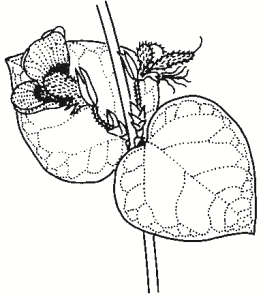Family:
Fabaceae
Platylobium formosum
Handsome Flat-pea
Other Names:
First Nations Name(s):

Name Origin:
Platylobium — from Greek platys, flat, and lobos, pod, referring to flat pods.
formosum — from Latin formosus, beautiful.
Regional Subspecies:
Occurrence:
Regional:
Widespread, in most areas of the region.
Australia:
Qld, NSW, Vic, Tas.
Habitat:
Various habitats, from heath to rainforest margins.
Habit:
Erect, straggling or prostrate shrub, to 2.5 m high. Green leaves 1-6.5 cm long.
Site Preference:
Moist well-drained soil in semi-shade. Tolerates frost and drought.
Characteristics:
Very variable in leaf shape, leaf size, flowers and pods.
Flowering:
Yellow and red, spring to early summer.
Seed Collection:
Mid to late Dec. Monitor closely as seeds shed immediately or very soon after maturity. Ensure collection by securing nylon stockings or paper bags to fruiting branches after flowering.
Propagation:
From scarified seed (which may be difficult to germinate); from cuttings of young growth, or layered stems. Pour boiling or very hot water over seeds and soak until water cools. Dry to prevent rotting and sow. Germination takes 3-4 weeks. Suitable for direct seeding in pots (2-3 seeds per pot). Add local soil to potting mix to introduce beneficial micro-organisms, and enhance success.
Regeneration:
From seed, particularly after fire.
VALUES:
Shade & Shelter:
Useful low-level cover in windbreaks. Important component of understorey.
Land Protection:
Legume — improves soil fertility through ‘fixing’ nitrogen.
Wildlife:
Good habitat. Native bees, wasps and butterflies pollinate flowers. Parrots, including the Red- rumped Parrot and Turquoise Parrot, and finches eat seeds.
Ornamental:
Highly attractive ornamental for gardens and embankments, particularly when flowering.
Other:
Very adaptable in cultivation.
